John Groves
Operetta Research Center
30 June, 2019
Imagine sitting under the stars in a beautiful German Schlossgarten, totally relaxed, watching a hugely enjoyable operetta by Emmerich Kálmán – this is what I had the pleasure of doing on the hottest day of the year whilst Theater & Orchestra Neubrandenburg-Neustrelitz entertained me, and 1,500 others, with a performance of Die Bajadere. It is amazing that a town of 20,000 can boast a full-time theatre that has music theatre, dance and (!) a drama company, and a standard so consistently high.
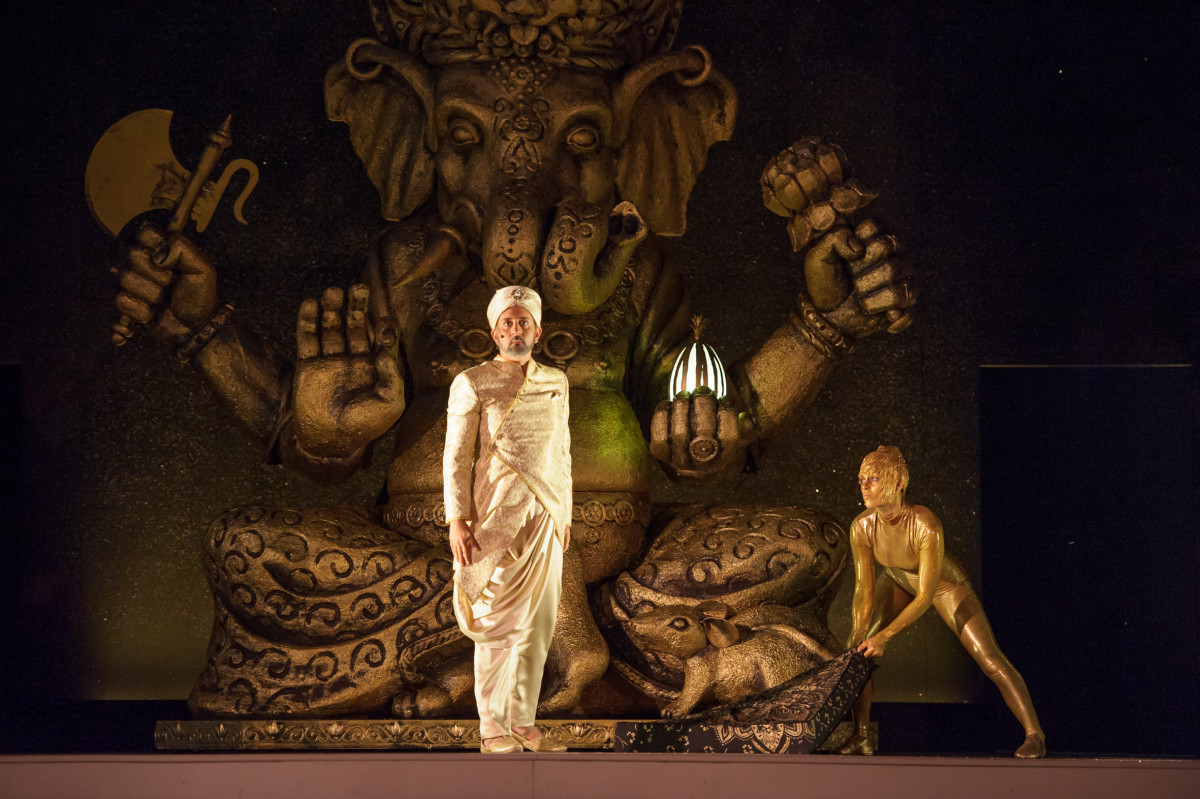
Andrés Felipe Orozco as Prince Radjami in “Die Bajadere” in Neustrelitz, 2019. (Photo: TOG / Jörg Metzner)
Bajadere, dating from 1921, was the third most successful Kálmán stage work, after Die Csardasfürstin (1915) and Gräfin Mariza (1924), running for a year at the Viennese Carl-Theater when it originally came out – with Louis Treuman in the lead (the first Danilo in Die Lustige Witwe). The score contains one of Kálmán’s catchiest dance tunes: “Fräulein, bitte woll’n Sie Shimmy tanzen!” And one of his most languorous waltzes: “Rosen aus Djeipur.” These days, however, the show seems to be rarely revived, managements preferring the other two operettas when choosing a “Hungarian” flavoured Kálmán operetta. Which is a great loss!
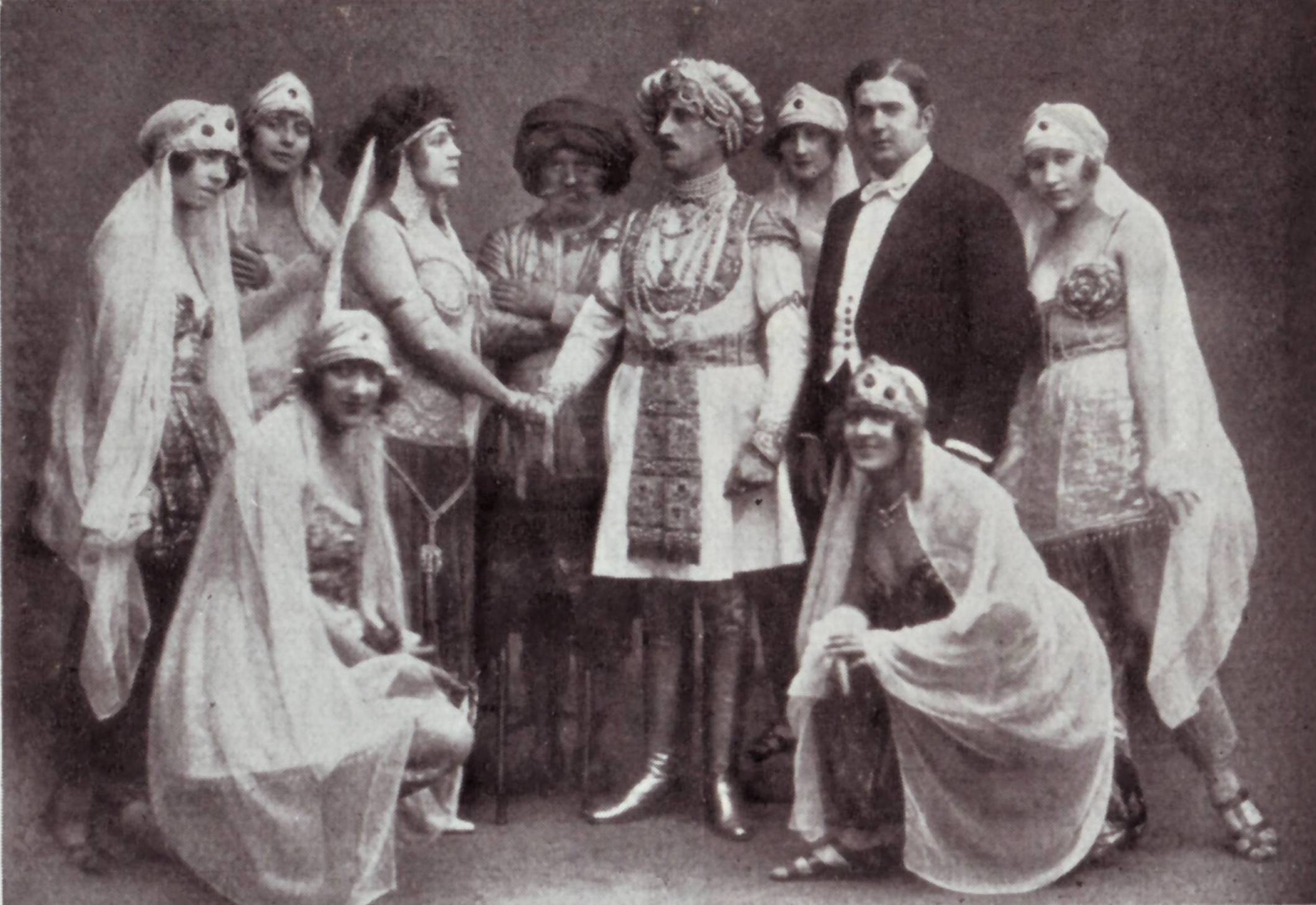
The original 1921 cast of “Bajadere,” with tenor Louis Treumann as Radjami and Christl Mardayn as Odette. (Photo: Operetta Research Center)
The plot (libretto by the ever resourceful Julius Brammer and Alfred Grünwald, Kálmán’s new writing-partners from 1921 onwards) is this: dashing Indian Prince Radjami, a stately portrayal by Andres Felipe Orozco, falls in love with glamorous Odette Darimonde, a French operetta star, exquisitely sung by Laura Scherwitzl. He tries to win her over by hypnotizing her and seducing her with oriental rhythms. Eventually he gets her to agree to marry!
The joy of Bajadere is the sub-plot, though. Emancipated Marietta (Viola Zimmerman) is married to Louis Philipp (Robert Merwald), a bore, so she’s having an affair with silly-ass Napoleon St Cloche (Bernd Könnes). A happy ménage a trios, as far as she’s concerned. In the course of the evening she divorces Louis, marries Napoleon, divorces Napoleon, because he is even more boring than Louis, and marries Louis again. These were modern times indeed.
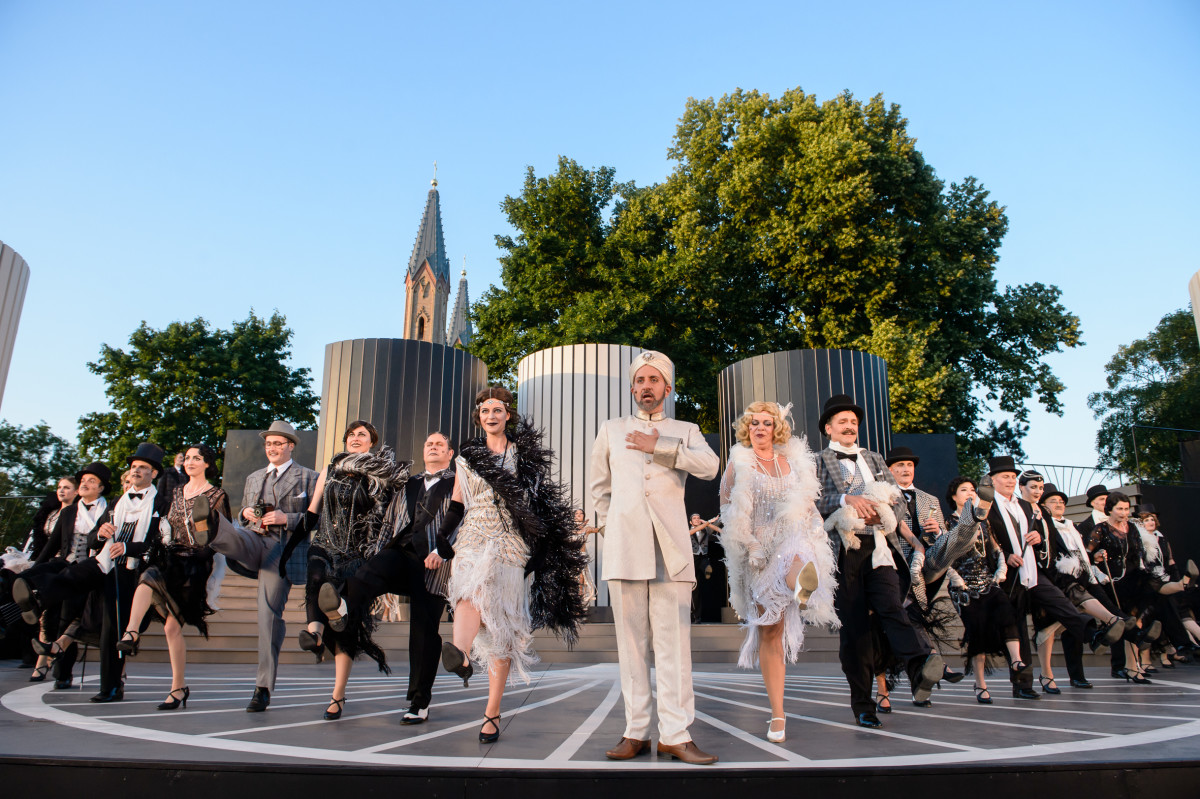
The ensemble of “Die Bajadere” in Neustrelitz, 2019. (Photo: TOG / Jörg Metzner)
Bernd Könnes is superb in his farcical role. He has charisma and lifts the production whenever he is onstage. This is due not only to his very attractive voice, which has a slight tremor throughout its compass and ringing, well placed, high notes, but also to the energy he is able to demonstrate, especially in his dialogue and his physicality.
At one point in Act Three he sits on a bar stool by jumping on it from behind, and he makes it look so easy, and very funny!
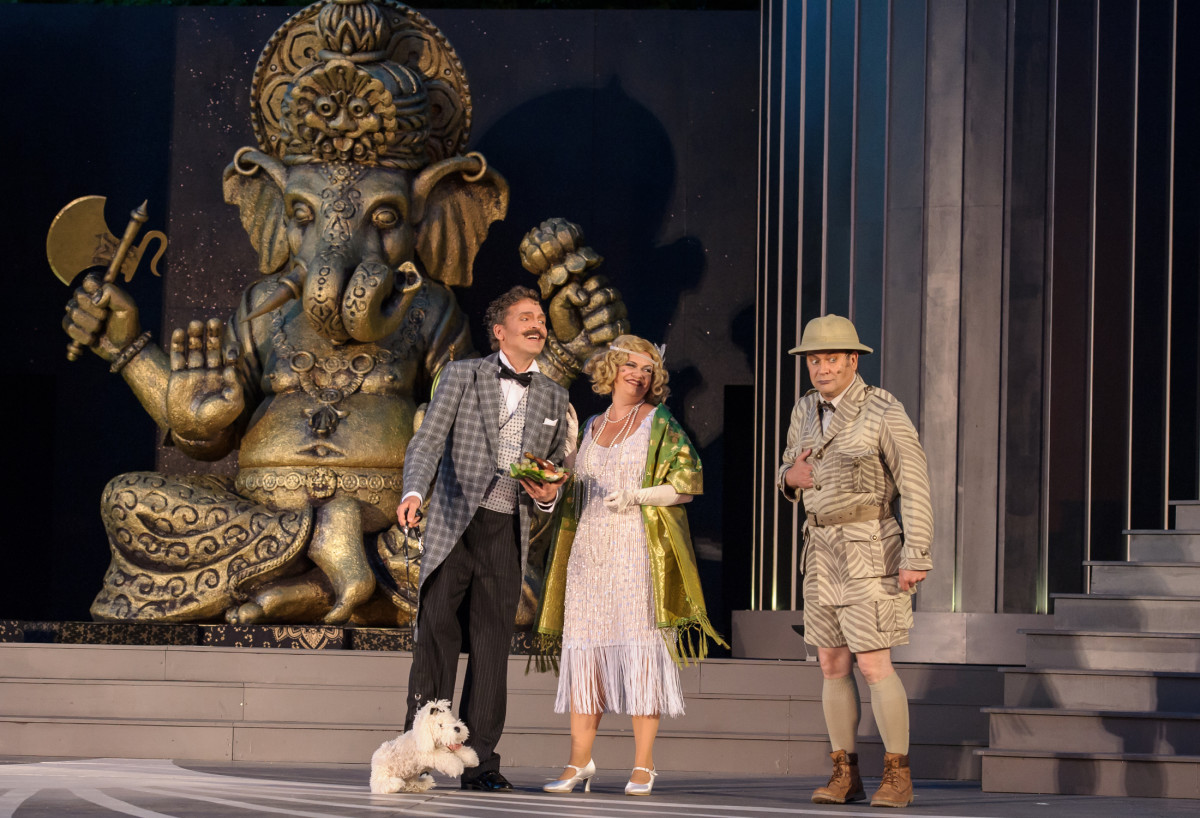
Robert Merwald as Louis Philipp La Tourette, Viola Zimmermann as Marietta, and Bernd Könnes as Napoleon St. Cloche (left to right) in “Die Bajadere” in Neustrelitz, 2019. (Photo: TOG / Jörg Metzner)
His portrayal is similar to the Claude Hulbert style of acting, for those old enough to remember. He has been given two superb costumes (by Monika Biegler), the first of which is the grossest safari suit you will ever see, complete with stripes, the second being the loudest check pattern suit possible. His Act Two description of his battle with a tiger (one wonders whether the authors had seen Vivian Ellis’ Mr. Cinders) was totally hilarious – however poor one’s knowledge of German!
Herr Koennes is more than ably assisted by Viola Zimmerman. Her singing voice is more than a match for his, having a wide compass and solid high notes. She has the true gift of comedy and the highlights of this staging are all when both are “on” together.
Robert Merwald is not given as much opportunity as the two artistes listed above, but he makes the most of those he gets, especially when he appears with two new “girl friends” after his divorce.
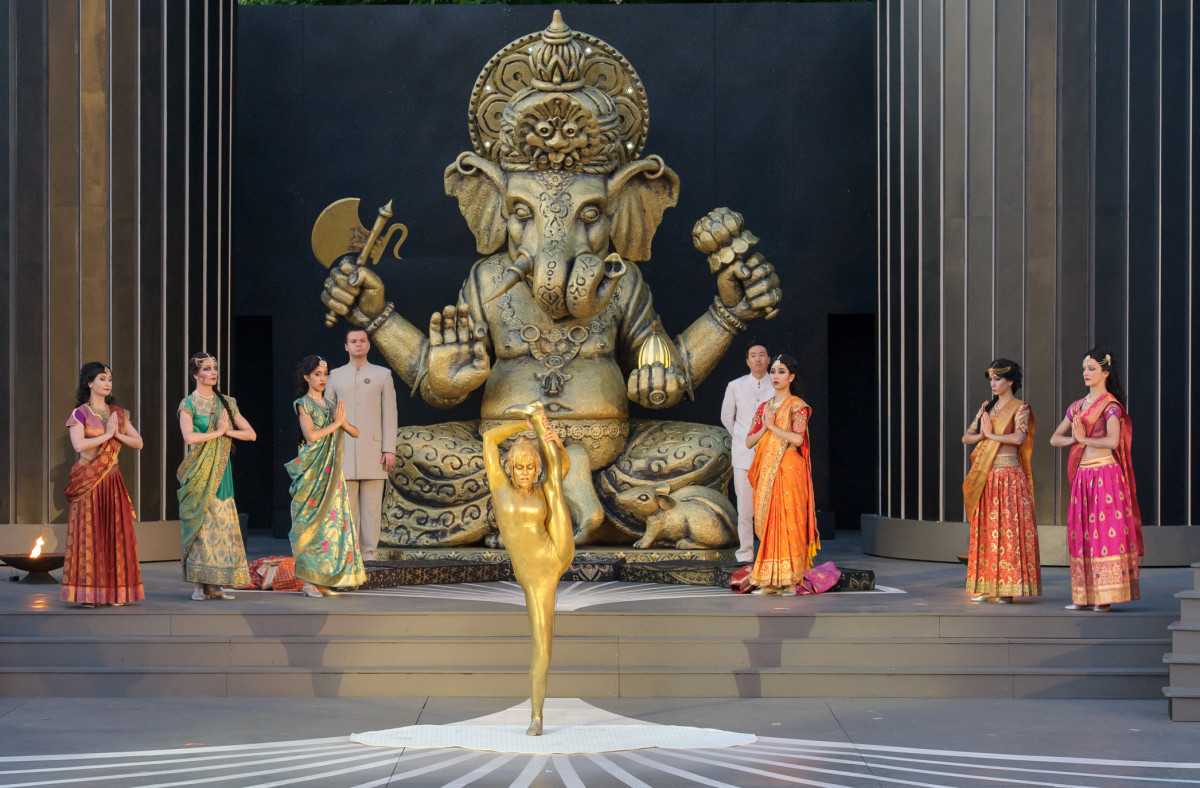
Nina Burri dancing in a “golden” outfit in “Die Bajadere” in Neustrelitz, 2019. (Photo: TOG / Jörg Metzner)
Christoph Deuter has the rare gift of making much more out of a role than he is given. He plays the role of a newspaper photographer, with no (or very few!) lines to say, but he always seems to be “hanging around” onstage doing something witty, without taking the focus away from what we are supposed to be looking at
Oberst Parker, the British “Resident from Lahore,” is suitably pompous and amusing, but pompous as only Germans can be. Kálmán introduces him with the British National Anthem, or rather: the stage director of this production does.
Direction and choreography is by Pascale-Sabine Chevroton. She is most successful when dealing with the dialogue, which is imaginatively directed with contrasts of pace always building to climaxes and integrated with the musical numbers. She also realises that, when played with a lightness of touch, it is also a very amusing show!
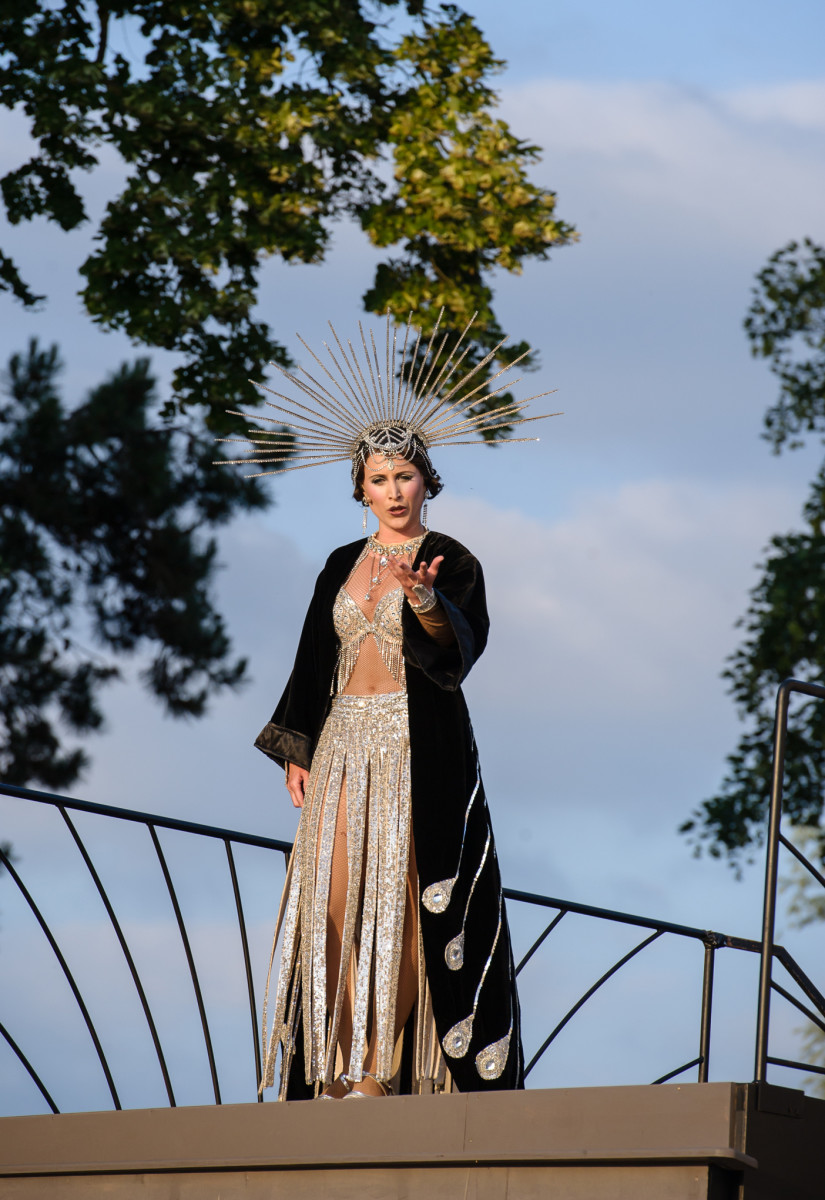
Laura Scherwitzl as Odette in “Die Bajadere” in Neustrelit,z 2019. (Photo: TOG / Jörg Metzner)
The multi-purpose set consists of two broad flights of stairs left and right, plus several semi-circular columns which can be rotated and moved around to always provide interest, all painted in black and off-white, as well as a grey stage floor, which is decorated with an Indian head dress to match the one on Odette’s glorious cloak – which she seems to spend most of the time flinging onto the floor! In fact, throughout, costumes appear lavish and always appropriate.
Lighting (Roland Lück/Matthias Kley) is much more subtle than usual in an open-air production, especially once darkness falls.
The orchestra, under the direction of Panagiotis Papadopoulos, plays Kálmán’s shimmering and shimmy infused music stylishly.

John Groves on the road, visiting operetta performances throughout Europe. (Photo: Private)
I had a hugely enjoyable evening in Schlossgarten Neustrelitz: even at 11 pm as I was walking back to Hotel Schlossgarten, which I can highly recommend, it was still warm, and I was still chuckling at Bernd Koennes’ “Napoleon” and humming Kálmán’s melodies. As I said above, Die Bajadere is rarely staged so if you are able to travel one hour northwards from Berlin, I can thoroughly recommend this production.
There is a recent recording in German on CPO and an English one from Ohio Light Opera, but the Neustrelitz production is much more fun!
For more information and performance dates, click here.
